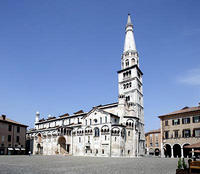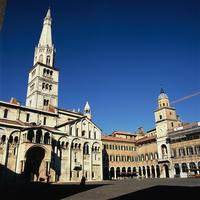You are in: Europe -> Italy -> Cathedral, Torre Civ... , and traditional search or Image Gallery will yield results of this site only
Cathedral, Torre Civica and Piazza Grande, Modena
| Site number: | 827 |
|
| Type of site: | Cultural | |
| Date: | 12th-century | |
| Date of Inscription: | 1997 | |
| Location: | Europe, Italy, Emilia-Romagna Region, City and Province of Modena | |
Up to 75 images are shown here. Click on each for more details or on Image Gallery for more images.
| Description: | The glorious 12th-century cathedral at Modena was built by two illustrious artists -Lanfranco and Wiligelmus. The cathedral supremely illustrates early Romanesque art. With its piazza and soaring tower, it bears witness to the confidence of its builders and the strength of the commissioning Canossa dynasty. --WHMNet paraphrase from the description at WHC Site, where additional information is available. | |
| Modena Cathedral, the cathedral, or "Duomo" in Italian, of Modena, Italy, is one of the most important Romanesque buildings of Europe and a World Heritage Site. The body of the late famed tenor Luciano Pavarotti, a native of Modena, is lying in state in the Duomo, and funeral services for him will be held there. The Torre della Ghirlandina or Torre Civica is the bell tower of the Cathedral of Modena, in Emilia-Romagna, Italy. Standing at 86.12 metres, the tower is the traditional symbol of Modena, being visible from all directions outside the city. The structure was set up in 1179 on five floors, initially called Torre di San Geminiano. To compete with Bologna's towers, the commune added the characteristic octagonal cusp, designed by Arrigo da Campione, one of the numerous masters from Campione who took part in the cathedral's renovation in the 13th-15th centuries. The top of the tower is decorated with two ghirlande (two marble railings), whence the name. In the interior, the Sala della Secchia room (with 15th century frescoes) is home of of a copy of the Secchia rapita depiction, a memory of the tower's former role as treasury of the Modenese commune. Also notable are the sculpted capitals in the Sala dei Torresani hall, in the fifth floor. And unique is the panorama enjoyable from the top. --Wikipedia. Text is available under the Creative Commons Attribution-ShareAlike License. | ||
| Source: | http://whc.unesco.org/en/list/827 | |
| Source2: | http://whc.unesco.org/en/list/827/video | |
| Reference: | 1. UNESCO World Heritage Center, Site Page. | |
















